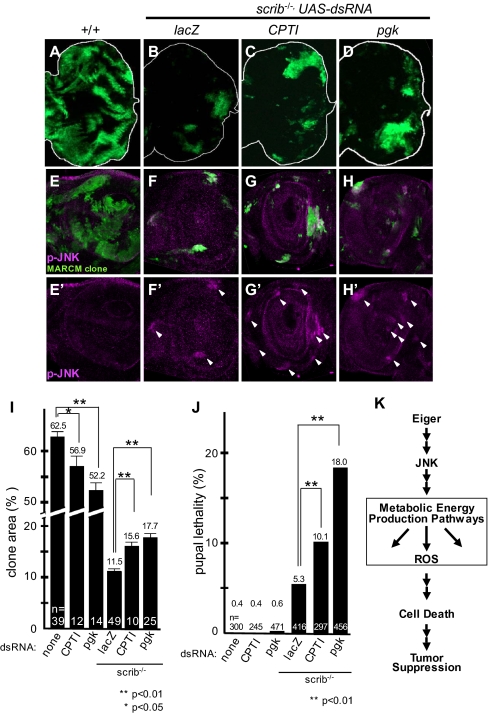Fig. 5.
Energy production-related molecules are required for the endogenous Eiger-JNK–induced cell death signaling that removes tumorigenic scrib cells. GFP-labeled WT (A, E, and E′), scrib mutant clones (B, F, and F′), or scrib mutant clones with RNAi constructs against energy production-related genes (C, D, G, G′, H, and H′) were generated in eye antenna imaginal discs. E–H show the anti-phospho-JNK antibody staining (magenta) and MARCM clone (green). E′–H′ show the anti-phospho-JNK antibody staining of E–H. Arrowheads indicate JNK activation in the clone. A–D show eye discs. E–H and E′–H′ show antenna discs. Anterior is to the left. (I) RNAi of energy production-related genes had a survival effect on scrib cells. (J) Pupal lethality caused by the clones induced in eye antennal discs. Asterisks in I and J indicate statistical significance, determined by Student's t test. *, P < 0.05; **, P < 0.01. Each bar in the graphs of I and J represents the mean ± SEM. The number of independent data points in I and J is indicated as n. (K) Schematic diagram for the JNK-mediated cell death signaling triggered by Eiger. Eiger-stimulated signaling is transduced to the JNK pathway through a Wengen/dTRAF2/dTAB2/dTAK1-mediated signal (9–12, 16–18). The activated JNK signaling is mediated by the energy metabolism-related pathway as shown in this paper. The deregulation of mitochondrial energy homeostasis, involving ROS production, was induced downstream of the activated JNK and energy production. This molecular mechanism is also used by physiological Eiger signaling to remove tumorigenic scrib cells.

